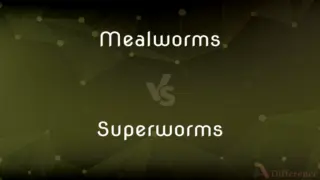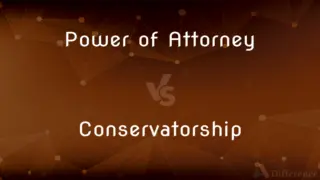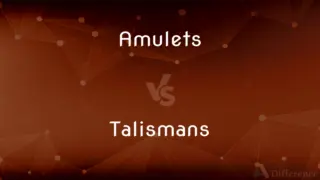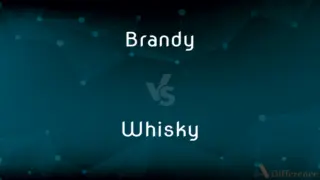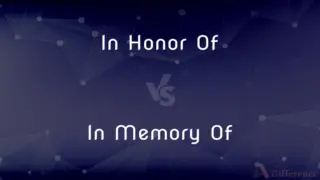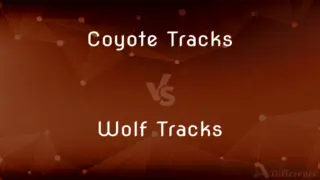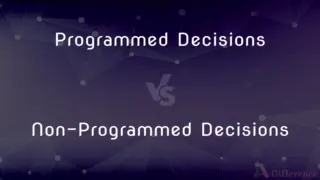Perspex vs. Polycarbonate — What's the Difference?
By Maham Liaqat & Urooj Arif — Updated on March 25, 2024
Perspex, a brand of acrylic, is known for its clarity and is more brittle, while polycarbonate is tougher and more impact-resistant but can yellow over time.
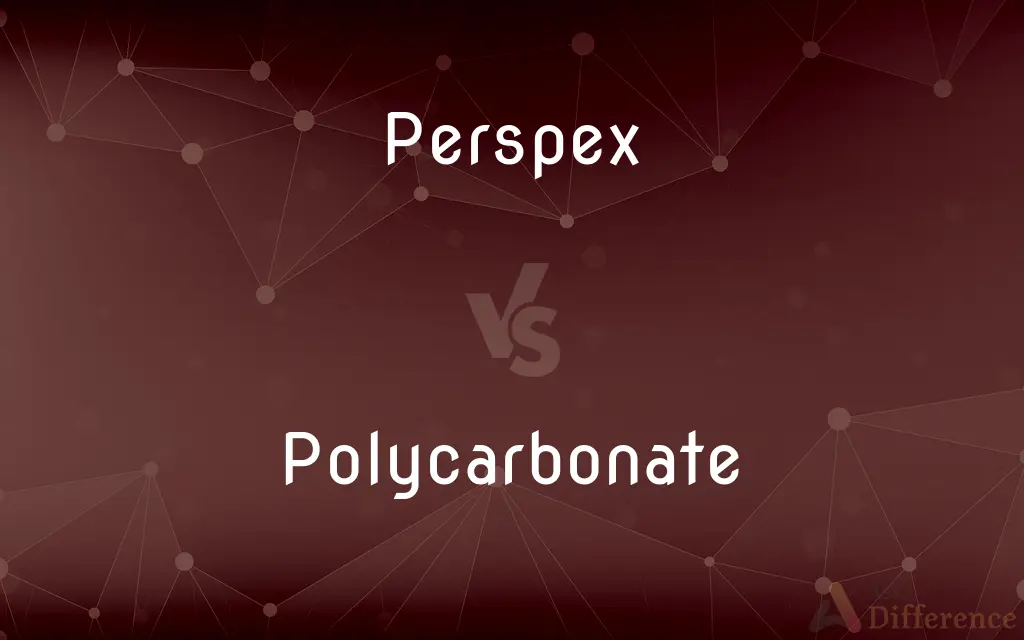
Difference Between Perspex and Polycarbonate
Table of Contents
ADVERTISEMENT
Key Differences
Perspex, a type of acrylic also known as PMMA (PolyMethyl MethAcrylate), is prized for its optical clarity and aesthetic appeal, making it a popular choice for applications where appearance matters, such as in signage, displays, and light fixtures. In contrast, polycarbonate is favored for its superior toughness and impact resistance, often used in situations where durability and safety are paramount, like in bullet-proof windows and eyewear.
While Perspex offers a glass-like transparency and is more resistant to UV-induced yellowing, it is more susceptible to cracking and breaking under stress or impact. On the other hand, polycarbonate, despite its strength, can become yellow over time when exposed to UV light, which can be a drawback for outdoor applications unless it is treated with a UV-resistant coating.
The fabrication and machining of Perspex are relatively straightforward due to its lower hardness and brittleness, allowing for easy cutting and shaping. Conversely, polycarbonate's high impact resistance and toughness make it more challenging to process but provide greater durability for fabricated products.
In terms of cost, Perspex is generally less expensive than polycarbonate, reflecting the differences in their physical properties and the applications they are suited for. Polycarbonate's higher price point is justified by its enhanced durability, making it a cost-effective choice for more demanding applications.
Choosing between Perspex and polycarbonate depends on the specific requirements of the application, including factors like visual clarity, impact resistance, UV stability, and cost. While Perspex is ideal for aesthetic applications with lower stress, polycarbonate is better suited for environments where strength and safety are critical.
ADVERTISEMENT
Comparison Chart
Clarity
High optical clarity, similar to glass.
Slightly less clear, can yellow over time.
Impact Resistance
More brittle, prone to cracking.
Extremely high, suitable for safety applications.
UV Resistance
Resistant to UV-induced yellowing.
Can yellow over UV exposure unless treated.
Fabrication
Easier to cut and shape due to brittleness.
Tougher, requiring more effort to machine.
Cost
Generally less expensive.
More expensive due to higher durability.
Compare with Definitions
Perspex
It is prized for its optical clarity and UV resistance.
Perspex skylights offer clear views and resist yellowing.
Polycarbonate
Polycarbonate is a tough, impact-resistant plastic used in safety applications.
The factory installed polycarbonate guards on machinery for protection.
Perspex
Perspex is a clear, glass-like acrylic material known for its aesthetic qualities.
The designer used Perspex for the sleek store displays.
Polycarbonate
Known for its durability, even in harsh conditions.
The outdoor lights were made of polycarbonate to withstand weather.
Perspex
Perspex is more brittle and can crack under stress.
The Perspex sheet cracked when it was accidentally dropped.
Polycarbonate
Often used where strength and safety are paramount.
Polycarbonate helmets provide high protection for cyclists.
Perspex
It is easier to fabricate and mold than polycarbonate.
They chose Perspex for the project because it was easy to shape.
Polycarbonate
Can yellow over time when exposed to UV light.
The old polycarbonate roof panels had yellowed, reducing clarity.
Perspex
Generally used in applications where appearance is key.
The museum used Perspex cases to showcase artifacts elegantly.
Polycarbonate
More challenging to machine than Perspex due to its toughness.
Special tools were needed to cut the thick polycarbonate sheets.
Perspex
Any tough, transparent plastic that is used instead of glass for windows.
Polycarbonate
Polycarbonates (PC) are a group of thermoplastic polymers containing carbonate groups in their chemical structures. Polycarbonates used in engineering are strong, tough materials, and some grades are optically transparent.
Perspex
A transparent thermoplastic acrylic resin
Polycarbonate
Any of a group of thermoplastics that are linear polyesters of carbonic acid, especially those derived from bisphenol A and phosgene, characterized by high-impact strength, light weight, and flexibility, and used as shatter-resistant substitutes for glass.
Polycarbonate
(chemistry) Any of a range of polymers of aromatic carbonates; they are used to make light, flexible alternatives to glass. Abbreviation: PC
Common Curiosities
What is Perspex best used for?
Perspex is best used for aesthetic applications where optical clarity and appearance are important, such as in signage, displays, and light fixtures.
Can Perspex be used outdoors?
Yes, Perspex can be used outdoors as it is resistant to UV-induced yellowing, but it is less durable compared to polycarbonate.
Is Perspex the same as acrylic?
Yes, Perspex is a brand name for acrylic, specifically PMMA (PolyMethyl MethAcrylate).
Why does polycarbonate yellow over time?
Polycarbonate can yellow when exposed to UV light due to the breakdown of its polymers, although UV-resistant coatings can mitigate this effect.
What makes polycarbonate suitable for safety applications?
Polycarbonate's high impact resistance and toughness make it ideal for safety applications, like bullet-proof windows and protective gear.
Is Perspex or polycarbonate easier to fabricate?
Perspex is easier to fabricate due to its lower hardness and brittleness, allowing for simpler cutting and shaping.
Are there any environmental considerations for using Perspex or polycarbonate?
Both materials have environmental impacts, particularly in terms of energy used in production and challenges in recycling.
Can polycarbonate be made UV resistant?
Yes, polycarbonate can be treated with UV-resistant coatings to prevent yellowing and extend its usability outdoors.
Can Perspex be recycled?
Yes, Perspex can be recycled, although the recycling process is less straightforward than for some other plastics.
Is it safe to use Perspex and polycarbonate in food applications?
Both materials are used in food applications, but it is important to ensure that the specific type used is food-grade and meets relevant safety standards.
How does the cost of Perspex compare to polycarbonate?
Perspex is generally less expensive than polycarbonate, reflecting differences in durability and application.
Which is more impact-resistant, Perspex or polycarbonate?
Polycarbonate is more impact-resistant than Perspex, making it suitable for high-stress applications.
Can I use Perspex for safety applications?
Perspex is not recommended for high-impact safety applications due to its brittleness; polycarbonate is a better choice.
What are the disadvantages of using polycarbonate?
The main disadvantages of polycarbonate include its tendency to yellow over time and the higher cost compared to materials like Perspex.
How do I prevent polycarbonate from yellowing?
Applying a UV-resistant coating can help prevent polycarbonate from yellowing when used outdoors.
Share Your Discovery

Previous Comparison
Gaiter vs. Spat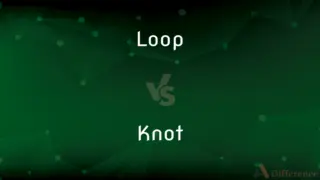
Next Comparison
Loop vs. KnotAuthor Spotlight
Written by
Maham LiaqatCo-written by
Urooj ArifUrooj is a skilled content writer at Ask Difference, known for her exceptional ability to simplify complex topics into engaging and informative content. With a passion for research and a flair for clear, concise writing, she consistently delivers articles that resonate with our diverse audience.














